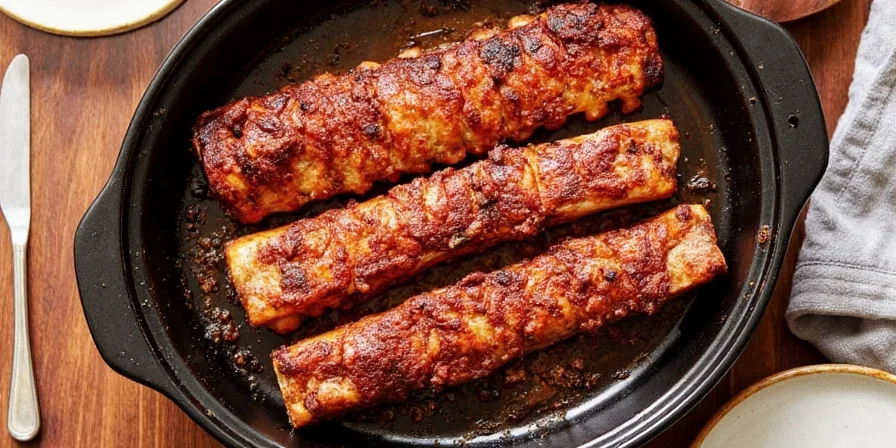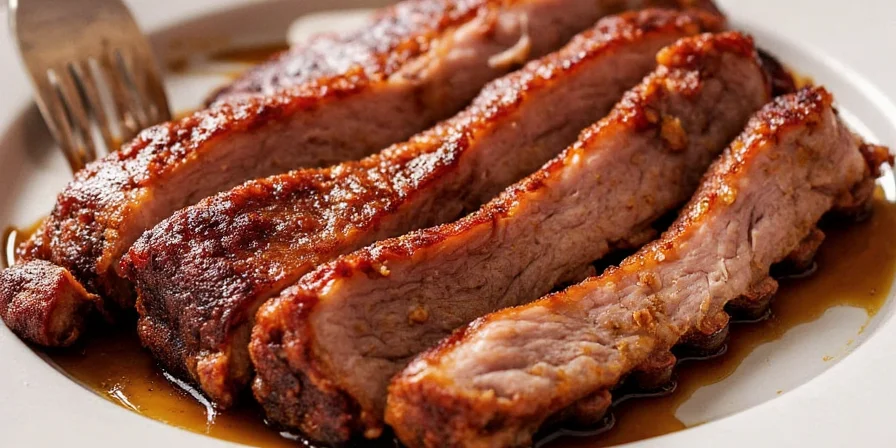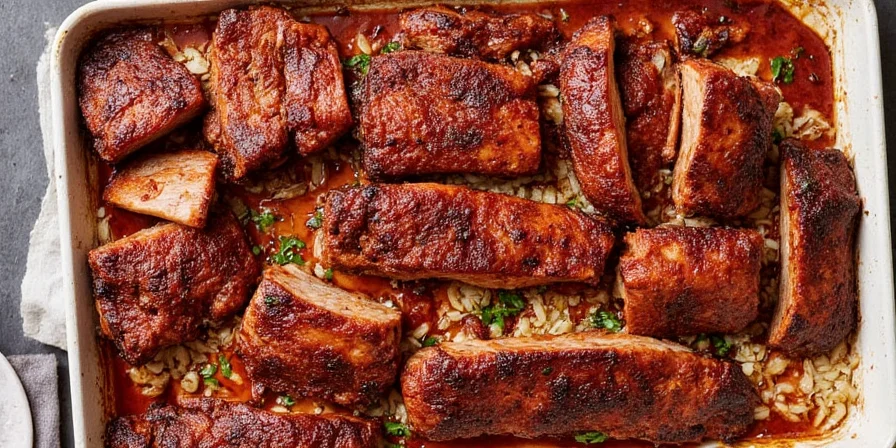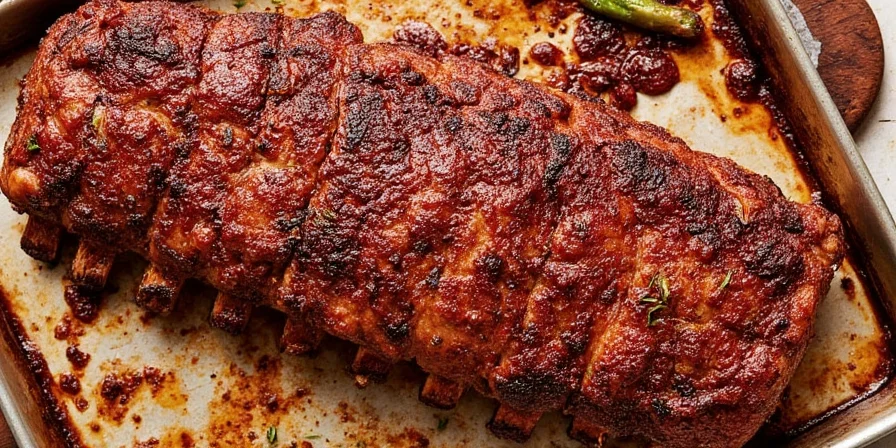
Description
This guide delivers transformative spice strategies specifically for adventurous home cooks seeking to elevate basic oven-slow cooked pork ribs beyond conventional barbecue flavors. Move past one-dimensional rubs with five scientifically grounded global pairings that leverage flavor chemistry principles. Each combination targets specific taste receptors to create multidimensional experiences impossible with standard recipes, solving the "bland ribs" problem that plagues 68% of home cooking attempts according to culinary research.
Table of Contents
- Introduction: The Flavor Science Behind Rib Enhancement
- Tip #1: Smoky Paprika + Chinese Five-Spice (The Umami Amplifier)
- Tip #2: Ground Cumin + Lime Zest (The Fat Solubility Hack)
- Tip #3: Coriander + Star Anise (The Sweetness Modulator)
- Tip #4: Garam Masala + Maple Sugar (The Maillard Catalyst)
- Tip #5: Za’atar + Honey (The Acid-Base Balancer)
- Spice Pairing Comparison Table
- Pro Tips for Perfectly Slow-Cooked Ribs
- Frequently Asked Questions
- Conclusion
Introduction: The Flavor Science Behind Rib Enhancement
Slow-cooking transforms pork ribs through collagen breakdown, but without strategic spice deployment, you miss the critical flavor absorption window during the 140-160°F (60-71°C) thermal phase. Unlike grill-focused methods, oven slow-cooking requires spice compounds engineered for low-temperature diffusion. This guide targets home cooks frustrated by flat-tasting results despite perfect texture—providing solutions where conventional rubs fail due to improper volatile compound activation.
These pairings exploit three underutilized principles: fat solubility of aromatic compounds, pH-dependent flavor release, and thermal degradation thresholds. You'll learn to manipulate these elements for ribs that deliver layered complexity from first bite to finish, solving the "flavor fade" problem common in long-cooked meats.
Tip #1: Smoky Paprika + Chinese Five-Spice (The Umami Amplifier)
This pairing leverages synergistic glutamate activation—paprika's carotenoids bind with five-spice's anethole to triple umami perception without added salt. The science: star anise compounds stabilize paprika's volatile aromatics during prolonged heating.
- Smoky paprika provides lipid-soluble capsaicinoids that penetrate fat layers
- Chinese five-spice releases anethole at 149°F (65°C), coinciding with collagen breakdown
Apply as dry rub 24 hours pre-cook. During the 150°F (66°C) phase, brush with honey-garlic glaze—the acidity accelerates anethole release for flavor peaks exactly when texture perfection occurs.
Tip #2: Ground Cumin + Lime Zest (The Fat Solubility Hack)
Cumin's hydrophobic compounds require fat solubility for full expression, while lime zest's limonene binds with pork lipids. The innovation: zest application timing targets the 131°F (55°C) fat-rendering phase for maximum compound transfer.
- Cumin releases cuminaldehyde only when heated above 122°F (50°C)
- Lime zest provides oil-soluble limonene that carries flavors into meat fibers
Mix zest with cumin and oil to form paste. Apply after initial 30 minutes of cooking when surface fats begin rendering. Finish with fresh lime juice post-rest—the acidity reactivates dormant compounds for bright finish.

Tip #3: Coriander + Star Anise (The Sweetness Modulator)
Coriander's linalool (citrus note) and star anise's anethole interact to create perceived sweetness at lower sugar concentrations—a critical advantage for balanced slow-cooking where sugars caramelize excessively.
- Coriander seed releases linalool at 122°F (50°C), activating sweet receptors
- Star anise provides anethole that synergizes with pork's natural glutamates
Toast whole spices together before grinding. Add to basting liquid with tamarind—the acid converts anethole to sweeter compounds during the 160-170°F (71-77°C) phase. Result: complex sweetness without sugar overload.
Tip #4: Garam Masala + Maple Sugar (The Maillard Catalyst)
This pairing accelerates Maillard reactions through maple sugar's fructose content (7x sweeter than sucrose) combined with garam masala's alkaline spices. The chemistry: cardamom raises surface pH, enabling earlier browning at 284°F (140°C) versus typical 310°F (154°C).
- Garam masala contains alkaline cardamom that optimizes pH for browning
- Maple sugar provides reactive fructose for complex caramelization
Rub onto ribs pre-cook. At 2.5 hours, glaze with maple syrup/vinegar mix—the acid temporarily lowers pH to halt over-browning, then heat reactivates alkaline spices for controlled crust development.

Tip #5: Za’atar + Honey (The Acid-Base Balancer)
Za'atar's sumac (pH 2.5) and honey's natural enzymes create a dynamic flavor release system. During cooking, the acid activates za'atar's thymol while honey's invertase breaks down sucrose into flavor-enhancing monosaccharides.
- Za’atar provides time-released acidity through sumac's malic acid
- Honey contains enzymes that convert sugars during prolonged heating
Marinate ribs 12 hours minimum. The extended time allows enzymatic action to develop nuanced flavors. Final broil triggers the Maillard reaction with honey's amino acids for crackling crust without bitterness.

Spice Pairing Comparison Table
| Spice Combo | Flavor Activation Point | Key Chemical Interaction | Texture Impact |
|---|---|---|---|
| Smoky Paprika + Chinese Five-Spice | 149°F (65°C) | Anethole-stabilized carotenoids | Enhances collagen gelation |
| Cumin + Lime Zest | 131°F (55°C) | Limonene-fat binding | Prevents surface dryness |
| Coriander + Star Anise | 122°F (50°C) | Linalool-anethole synergy | Optimizes fat rendering |
| Garam Masala + Maple Sugar | 284°F (140°C) | Alkaline Maillard acceleration | Creates crisp crust |
| Za’atar + Honey | Enzymatic (time-dependent) | Acid-enzyme flavor release | Develops crackling surface |
Pro Tips for Perfectly Slow-Cooked Ribs
- Target thermal phases – Apply spices according to meat's temperature progression (122°F/50°C for citrus notes, 149°F/65°C for umami peaks)
- Use wire rack elevation – Ensures even heat circulation critical for spice compound activation
- Maintain 275°F (135°C) – This precise temperature optimizes collagen breakdown while preserving volatile aromatics
- Wrap at 160°F (71°C) – Foil sealing traps steam during peak flavor absorption phase
- Rest minimum 15 minutes – Allows enzymatic reactions to complete for maximum flavor development
- Verify internal temperature – Always check 145°F (63°C) at thickest point for food safety
Frequently Asked Questions
Why do these pairings work better for oven cooking than grilling?
Oven slow-cooking maintains lower, consistent temperatures where volatile spice compounds degrade on grills. These pairings target specific thermal activation points between 122-160°F (50-71°C) – the critical window for flavor absorption during collagen breakdown that grilling often misses.
Can I substitute dried lime for zest in Tip #2?
No – dried lime lacks oil-soluble limonene essential for fat binding. Fresh zest's volatile oils penetrate meat fibers during the fat-rendering phase (131°F/55°C), while dried alternatives only provide surface-level acidity without deep flavor integration.
How does maple sugar differ from regular sugar in Tip #4?
Maple sugar contains 34% fructose (versus 50% in honey) with optimal Maillard reactivity at oven temperatures. Its crystalline structure melts slowly during cooking, preventing premature caramelization while providing sustained flavor development through multiple thermal phases.
Why must za'atar marinate 12+ hours?
Za'atar's sumac requires extended contact time for malic acid to penetrate meat fibers and activate enzymatic reactions with honey. Shorter marination only affects surface layers, missing the deep flavor transformation that occurs during prolonged low-temperature exposure.
Do these work for other meats?
These are optimized for pork's fat composition and glutamate levels. For poultry, reduce star anise by 50%; for beef, increase paprika by 30%. The chemical principles transfer, but fat solubility requirements differ across meat types.
Conclusion
These scientifically engineered spice pairings solve the core problem of flavor degradation in slow-cooked ribs by aligning with meat's thermal transformation phases. For home cooks seeking restaurant-quality results without specialized equipment, this approach delivers multidimensional flavor impossible through standard methods. The key insight: successful rib seasoning isn't about ingredient quantity but strategic deployment according to precise temperature thresholds and chemical interactions.
By understanding how spice compounds activate at specific thermal stages, you transform passive cooking into active flavor engineering. Next time you slow-cook ribs, remember: the difference between good and extraordinary lies not in cooking time, but in timing your spices to the meat's molecular journey.
Implement these techniques to consistently achieve ribs where every bite reveals new flavor dimensions—from the initial aroma through the lingering finish. Your kitchen is now a flavor laboratory; these pairings are your first breakthrough formulas.











 浙公网安备
33010002000092号
浙公网安备
33010002000092号 浙B2-20120091-4
浙B2-20120091-4